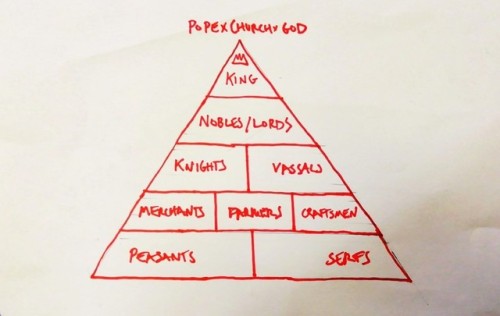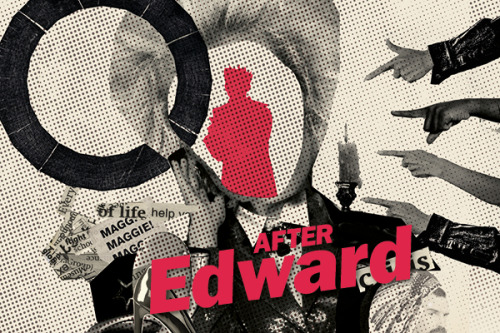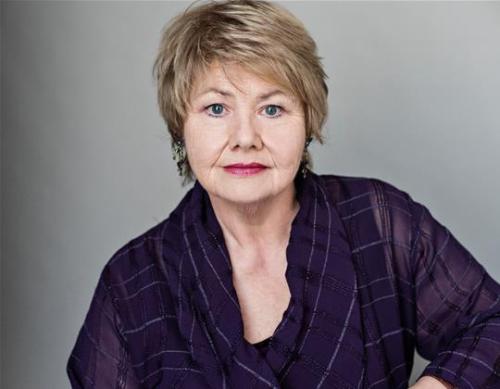#edward ii
Staging Renaissance plays in the 21st century: Church and the Feudal system.
George Nichols is the Assistant Director for Edward IIandAfter Edward. He is writing a blog series about the processes and ideas in these two plays.
In this blog, George discusses the relevance of the Church and the Feudal system in 14th century England. In further blogs, he looks at the importance of understanding the etiquette of the time the play is set and the meaning of words and how they have evolved.
Edward II was written in the 16th century, set in the early 14th century and will be performed to a 21st-century audience in a building that has the central goal of recreating the performance conditions of the early modern stage.
This convoluted series of perspectives brings with it a number of challenges and questions. For example, how do we deal with obscure allusions and references? How do we work with words that are no longer in common usage or now have different meanings? How do we stage peculiar and antiquated codes of etiquette from the day?
Church and the Feudal system
In the medieval period, societal order was structured in a hierarchical triangle known as the feudal system. At the top we have the king, believed to be appointed by the church and god; the king’s right to rule and the right of his heir to inherit the throne is known as the divine right of kings. This was common knowledge among our company, however, something we knew less about was the specific relationship between the church and monarchy. You can see from the diagram above that this hierarchy is supposedly ordained by God, but what happens if a king wants to get rid of an archbishop or make changes to the church? The answer to this is more convoluted as the king and the church seem to validate each other. If a king wants to be rid of an archbishop they must get permission from Rome, and when the monarch tried to do things like tax the church or change its structure Rome often voiced its displeasure.
In our cut of Edward II, we’ve tried to bring the church to the fore, partly for clarity of storytelling and partly because it’s a fascinating aspect of the play. But how does the above research contribute to the way we stage Edward II?
Well, something we grasp from both Marlowe’s play and the real life of Edward II is that civil war and deposition were highly unusual and that the stakes of this play must be extremely high. From our research, we know that the final power the church had available was to excommunicate the King, and thus end the divine right of his successors. By using this, or at least being aware of it in the scenes between the Archbishop of Canterbury and King Edward, we can heighten the stakes and ramp up the tension for the audience.
Edward II, written by Christopher Marlowe will be directed by Nick Bagnall. After Edward, a contemporary response to Marlowe’s piece was written by Tom Stuart and will be directed by Brendan O'Hea. Tom will play Edward in both productions. The cast will be the same for both plays.
Post link
Staging Renaissance plays in the 21st century: Etiquette.
George Nichols is the Assistant Director for Edward IIandAfter Edward. He is writing a blog series about the processes and ideas in these two plays.
In this blog George looks at the importance of understanding the etiquette of the time the play is set. In further blogs he discusses the relevance of the Church and Feudal system in 14th century England and the meaning of words and how they have evolved.
Edward II was written in the 16th century, set in the early 14th century and will be performed to a 21st-century audience in a building that has the central goal of recreating the performance conditions of the early modern stage. This convoluted series of perspectives brings with it a number of challenges and questions. For example, how do we deal with obscure allusions and references? How do we work with words that are no longer in common usage or now have different meanings? How do we stage peculiar and antiquated codes of etiquette from the day?
Not only is it difficult to answer these questions because we’re making our best-educated guesses about the world the play was written in, but also because Marlowe was writing about a period he likewise didn’t live in.
Engaging with these questions is something at the heart of what the Globe experiment is all about, and in week one of rehearsals for Edward II they’ve certainly been a central preoccupation of ours. As the assistant director, a lot of the responsibilities of research fall to me. Over the last couple of weeks, I’ve been doing a lot of work on the etiquette of the court during the 14th century, the relationship between church and monarchy, the feudal system and 16th-century definition of words with the intention of contributing to the fabric of the world of the play. We’ve then worked to interpret what is most important about this information and how it can best be translated or used to create a coherent and, of course, enjoyable production.
Etiquette
Etiquette from the 14th century is positively barmy, although they might say the same thing about today. It’s easy to forget that we still obey a code of etiquette that we perceive as innate behaviour, but which is actually socially determined; just think about the way we queue, the way we dress or the way we behave in the workplace.
In medieval England, there were a number of writings about proper conduct for people from all different walks of life. Some of these instructions sound ridiculous, for example in Daniel Beccles 3000 word poem The Etiquette of Man, it stipulates:
In front of grandees, do not openly excavate your nostril by twisting your fingers.
And in The Book of Courtesy it says:
Don’t put up at a red (haired and faced) man or woman’s house.
These are some of the silliest examples, but if we get bogged down in etiquette then we can quickly end up in a place where the play becomes difficult to stage, and where we leave the audience thoroughly confused. What’s important is to understand the role etiquette plays in Edward II and how we can best use it to tell the story effectively. By working on when the rules are followed and when they are broken, we can emphasise a threat to social order, an integral theme of the play.
Edward II, written by Christopher Marlowe will be directed by Nick Bagnall. After Edward, a contemporary response to Marlowe’s piece was written by Tom Stuart and will be directed by Brendan O'Hea. Tom will play Edward in both productions. The cast will be the same for both plays.
Post link
Shame.
George Nichols is the Assistant Director for Edward IIandAfter Edward. He is writing a blog series about the processes and ideas in these two plays.
Edward II, written by Christopher Marlowe will be directed by Nick Bagnall. After Edward, a contemporary response to Marlowe’s piece was written by Tom Stuart and will be directed by Brendan O'Hea. Tom will play Edward in both productions. The cast will be the same for both plays.
‘You can marry, you can adopt, you can say you’re gay in the workplace, but what about the things we haven’t had to time to deal with? The insidious things like shame that affect us silently every day?’
It’s the first week of rehearsals for After Edward,a production that will be performed in tandem with Christopher Marlowe’s Edward II in the Sam Wanamaker Playhouse. After Edward is a new play, written by Tom Stuart (who will be playing Edward) and featuring a cast that will run across both productions. We’re talking a lot about the relationship between Tom’s play and Marlowe’s and what unites them across a void of 400 years and what makes them so important for audiences today.
Some background. Edward II, the central character of Marlowe’s play, has a same-sex romantic relationship with, among others, Piers Gaveston. It’s an amazing play, not least for what it tells about gender and sexuality in the Renaissance period in which the play was written, and the earlier 14th century when the play was set. A big question we’re grappling with this week is what connects the experiences of Edward II, Marlowe and a gay man living in the modern era?
Each of these different periods has a vastly different perspective on gender and sexuality (something we’ll cover in the next blog) and so each of these people will have had a vastly different experience. In fact, in the era the play was written people weren’t labeled because of the acts they committed; all people were considered capable of all things and so an act didn’t define an individual. Yet one thing that remains true across the last 700 years is that at no point has the preference for same-sex relationships been a societal norm. Whether homosexuality has been accepted, tolerated, persecuted or hidden the society we live in has primarily been designed with white heterosexual men in mind.
The effect that living up to a hetero-normative ideal has on the individual that doesn’t fit is something that resonates throughout these plays. That effect is, among other things, shame.
We’re fortunate that our company is made up of people with different personal perspectives on gender and sexuality. At some point though, we can all attest to having felt shame of some kind at being unable to live up to an ideal that is thrust upon us.
Despite the progress that can be said to have been made in the 21st century, for the plethora of people who do not identify with heterosexual ‘norms’ it can be impossible to see oneself in the surrounding cultural and social environment. Just think of something like the couplings on Strictly Come Dancingor the way the sex education in schools is almost entirely based around the heterosexual experience. Not seeing yourself in the world can have the impact of making you feel that the life you want to live is not only abnormal but wrong.
Later in the week, we talk to Dr. Will Tosh from the Globe’s Research Department about how some productions eschew the homosexuality within Edward II entirely and make Gaveston and Edward’s relationship platonic. We agree this is a shame. One of the great connections we have found with both Edward II andAfter Edwardis how important they both are for allowing people to see themselves in the culture around them. As one of the company says, with regards to their first reading of After Edward:‘I wish I had seen this play when I was growing up’.
Tom began this week by telling us a story of him standing in Berkley Castle, where Edward II was executed, and looking around and thinking ‘this is where it happened, this is where he was, he would have seen this light and felt this darkness’. In After Edward,the characters often come back to the idea that they are just one part of a long and never-ending line; from the pornographic petroglyphs unearthed by archaeologists to Edward II himself. In the modern world, we live in it is important that these lives and stories are shared and celebrated, and that we make the world a place where no one feels shame for who they are or the life they lead. It’s essential that this belief is a guiding principle of the work we create and the culture we share.
Post link
Edward II/After Edward Cast.
Edward IIandAfter Edwardwill be performed by the same cast of actors. Nick Bagnall will direct Christopher Marlowe’s Edward II and Brendan O’Hea will direct After Edward, written by Tom Stuart in response to Edward II.
Examining ancestral relationships and notions of identity, sexuality and power, Marlowe’s Edward II sees King Edward recall his lover, Gaveston, from banishment, setting in motion a chain of events that culminate in some of the most shocking scenes in early modern theatre.
Tom Stuart’s new play After Edward, written specifically for the Sam Wanamaker Playhouse in response to Edward II, sees Edward return to the stage alone, bloodied and confused. He has no idea where he is, or how he got here, but he does have an ominous feeling that something is wrong.
Annette Badland will play Mortimer Senior in Edward II and Gertrude Stein in After Edward
Richard Bremmer will play Archbishop of Canterbury/ Spencer Senior in Edward II and Archbishop of Canterbury/Leather Man in After Edward
Richard Cant will play Earl of Lancaster in Edward II and Quentin Crisp in After Edward
Polly Frame will play Earl of Kent in Edward II and Harvey Milk in After Edward
Jonathan Livingstone will play Mortimer Junior in Edward II and Edward Alleyn in After Edward
Sanchia McCormack will play Earl of Warwick in Edward II and Margaret Thatcher in After Edward
Colin Ryan will play Spencer Junior in Edward II and Cowboy in After Edward
Tom Stuart will play Edward II in Edward II and Edward in After Edward
Beru Tessema will play Gaveston in both Edward II and After Edward
Katie West will play Queen Isabella in Edward II and Dorothy Gale and Maria Von Trapp in After Edward
TheEdward II Company will also include:
Nick Bagnall as Director
Bill Barclay as Composer
Kevin McCurdy as Fight Director
George Nicholls as Assistant Director
Wayne Parsons as Choreographer
Jessica Worrall as Designer
TheAfter Edward Company will also include:
Laura Moody as Composer
George Nichols as Assistant Director
Brendan O’Hea as Director
Tom Stuart as Writer
Siân Williams as Choreographer
Jessica Worrall as Designer
Edward II opens in the Sam Wanamaker Playhouse on 7 February.
After Edward opens in the Sam Wanamaker Playhouse on 21 March.
Post link













